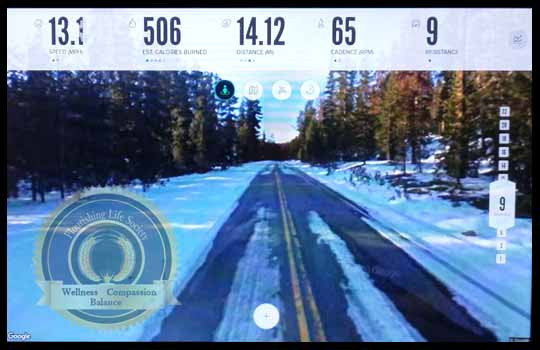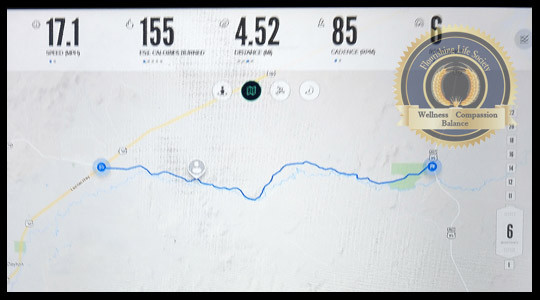Like many, life’s unexpected turns threw my routines into disarray, and before I knew it, extra pounds had crept on. Weight gain is insidious; you barely notice until one day, the mirror delivers a surprise. Frustrated with fleeting weight loss attempts, I stumbled upon a solution that clicked: embarking on a virtual cross-country journey using an exercise bike.
The Running Misadventure and Knee Pain
Running had been my go-to fitness method for years. From high school cross-country to adult jogs for stamina and weight management, I always returned to running.
Determined to shed the extra weight, I invested in new running shoes, downloaded a fitness app, and explored local trails. Despite being in my fifties, I rekindled my love for trail running, relishing the fresh air and the challenge of hill workouts.
However, my enthusiasm was short-lived. Each time I increased my mileage to a weight-loss-effective level, knee pain would flare up. I experimented with different shoes, knee supports, and softer running surfaces, but nothing alleviated the recurring inflammation.
Discovering Interactive Exercise Bikes
My desire to get fit and healthy remained strong. My grandchildren, or so I tell myself, needed an active grandpa.
Yet, the gap between wanting to be healthy and actually being healthy felt vast. My knees provided a convenient excuse to abandon regular exercise. As Art Markman, Ph.D., notes, “knowledge alone does not cause people to change their behavior. And even a commitment to change is not enough” (Markman, 2015).
An advertisement for a Peloton bike caught my attention. Intrigued by interactive fitness, I quickly dismissed the Peloton due to its high price. However, the concept of interactive spin classes and cycling trainers resonated with me.
Further research led me to Pro-Form’s version of the interactive bike. The Pro-TC, with its iFit subscription, offered access to virtual spin classes and trainer-led cycling routes worldwide. An enticing offer – a free bike with a three-year iFit subscription – sealed the deal. Purchase made.
First Encounters and Gradual Progress
Assembly complete, the bike was ready. My first virtual ride was a gentle tour around a Norwegian lake. Two miles in, my legs burned, and my heart pounded. Slightly discouraged, I ended the workout.
But adaptation was swift. My muscles and cardiovascular system responded quickly. I explored trainer-led sessions across various global trails and even ventured into virtual spin classes.
Then, I discovered the “create” feature. Connecting to Google Maps, I could design custom routes, and the bike would simulate the terrain. I virtually cycled through my childhood town of Tucson, explored Paris, and cruised through Charleston.
The map feature wasn’t flawless. Instead of continuous video, the screen displayed a slideshow of Google Street View photos. Some areas lacked photo coverage altogether. However, the bike intelligently adjusted resistance for inclines, and photo gaps were minimal. The minor imperfections were acceptable.
Isabelle M. Baur and Roy F, Baumeister highlight the essence of self-control: “successful self-regulation allows people to subordinate short-term temptations to long-term goals, to trade the pleasure of immediate gratification for delayed rewards, and to tolerate the frustration that can be associated with persisting in the face of challenges or hard work” (Bauer & Baumeister, 2017. Kindle location: 2,097).
Yet, something was missing. I needed a more compelling, overarching goal to unify my workouts, something beyond just a few sporadic rides.
Setting a Transcontinental Goal
In a moment of clarity, it struck me: “I’m going to ride this exercise bike across the country,” I declared to my wife. Ever supportive of my ambitious ideas, she simply replied, “You do that, Troy.”
I was ready to commit, and immediate action was crucial. DiClemente emphasizes that the preparation stage “entails developing a plan of action and creating the commitment needed to implement that plan” (DiClemente, 2005). Furthermore, Gregg Krech cautions against procrastination: “most procrastination is caused by a tendency to make a decision, in the present moment, based on what we feel like doing at that moment. And if we don’t feel like doing something NOW, then we’re not likely to feel like doing it later, because…later will just be another NOW” (Krech, 2014).
Fueled by motivation, I hopped on the exercise bike and began my virtual cross-country journey from my California living room.
Initial progress was gradual, covering only a few miles daily. But within weeks, I was consistently riding twenty miles or more. Soon, I was virtually traversing the Sierra Nevada mountains and descending into Nevada.
 ProForm Stationary Bike. Engaging in a virtual cross-country cycling journey on a Pro-Form exercise bike for weight loss and fitness improvement.
ProForm Stationary Bike. Engaging in a virtual cross-country cycling journey on a Pro-Form exercise bike for weight loss and fitness improvement.
Breaking Down the Journey with Smaller Milestones
The grand goal of reaching Boston was made manageable by smaller, incremental objectives. Daily targets like “Reach Reno today” and weekly goals such as “Cross the Utah border this week” provided continuous motivation. We need goals to stay driven, but overly daunting, long-term goals can lead to discouragement and abandonment.
These mini-goals fueled my inspiration and pushed me to exert extra effort. I incorporated sprint intervals during flat virtual terrains and utilized the simulated hills for challenging climbs. Two months into my virtual ride, I felt a surge of momentum, much like Forrest Gump, as I virtually pedaled towards Nebraska.
 ProForm Stationary Bike Map Interface. Visualizing a virtual cycling route on the Pro-Form exercise bike's map interface, enhancing workout engagement and tracking progress.
ProForm Stationary Bike Map Interface. Visualizing a virtual cycling route on the Pro-Form exercise bike's map interface, enhancing workout engagement and tracking progress.
Tangible Fitness Achievements
This ambitious virtual journey wouldn’t be truly successful without achieving my primary fitness goal: weight loss. Here’s what transpired in my body during the initial six weeks:
- Weight reduction of twenty pounds.
- Resting heart rate decreased from the low 70s to the mid-50s.
- Blood pressure improved from a concerning 135/95 to a healthier 115/75.
A Successful Virtual Transcontinental Ride
Eventually, I reached virtual Boston. Like any long-term endeavor, obstacles arose. A move to a new home in the Midwest necessitated storing my exercise bike for a few months. At the new house, a back injury from yard work further paused my journey during recovery. Other unforeseen life events caused additional delays.
Yet, the goal of reaching Boston remained in my mind. I had to complete the virtual ride. I returned to the exercise bike and finished my transcontinental journey. To celebrate, my wife and I took a trip to Boston. The journey continues; I’m now virtually heading south from Boston towards the Florida Keys.
Related Concepts and Final Thoughts
An audacious goal like a virtual cross-country bike ride might not appeal to everyone. My wife, for instance, finds the Google Street View photos monotonous. She prefers her favorite iFit trainers and is effectively pursuing her fitness goals in her own way.
For me, cycling on my exercise bike has been transformative. My knees are happy, my fitness objectives are met, and my motivation remains strong as I virtually cycle across the American heartland.
Last Updated: August 15, 2024
Psychology of Wellness
Self-Improvement
Health and Fitness
Motivation Theories
Explore More from Psychology Fanatic
Subscribe for weekly updates on newly published articles.
Join 51.9K other subscribers
References:
Baumeister, Roy F.; Bauer, Isabelle M. (2017). Self-Regulatory Strength. K. D. Vohs, & R. F. Baumeister (Eds.), Handbook of Self-Regulation: Third Edition: Research, Theory, and Applications. The Guilford Press; Third edition.
DiClemente, Carlos C. (2005) Addiction and Change, Second Edition: How Addictions Develop and Addicted People Recover. The Guilford Press; Second edition.
Krech, Gregg (2014). The Art of Taking Action: Lessons from Japanese Psychology. ToDo Institute Books.
Markman, Art (2015). Smart Change: Five Tools to Create New and Sustainable Habits in Yourself and Others. TarcherPerigee; Reprint edition.
Resources and Articles
Visit Psychology Fanatic’s extensive collection of articles, definitions and database of referenced books.
*Many quotes are from books read cover to cover, forming an extensive library of notes. References are made to support or enhance article topics. Kindle location references are based on Kindle notes saving highlights.
Please note that some links are affiliate links, which may provide a small commission at no extra cost, supporting the creation of quality content.
Peer-reviewed article references are primarily from Deepdyve, a periodical database subscription. DOI references are added for reader convenience.
Thank you for visiting Psychology Fanatic, a product of nearly two decades of research and passion.
Topic Specific Databases:
PSYCHOLOGY – EMOTIONS – RELATIONSHIPS – WELLNESS – PSYCHOLOGY TOPICS
Share this:
Discover more from Psychology Fanatic
Subscribe to get the latest posts sent to your email.

